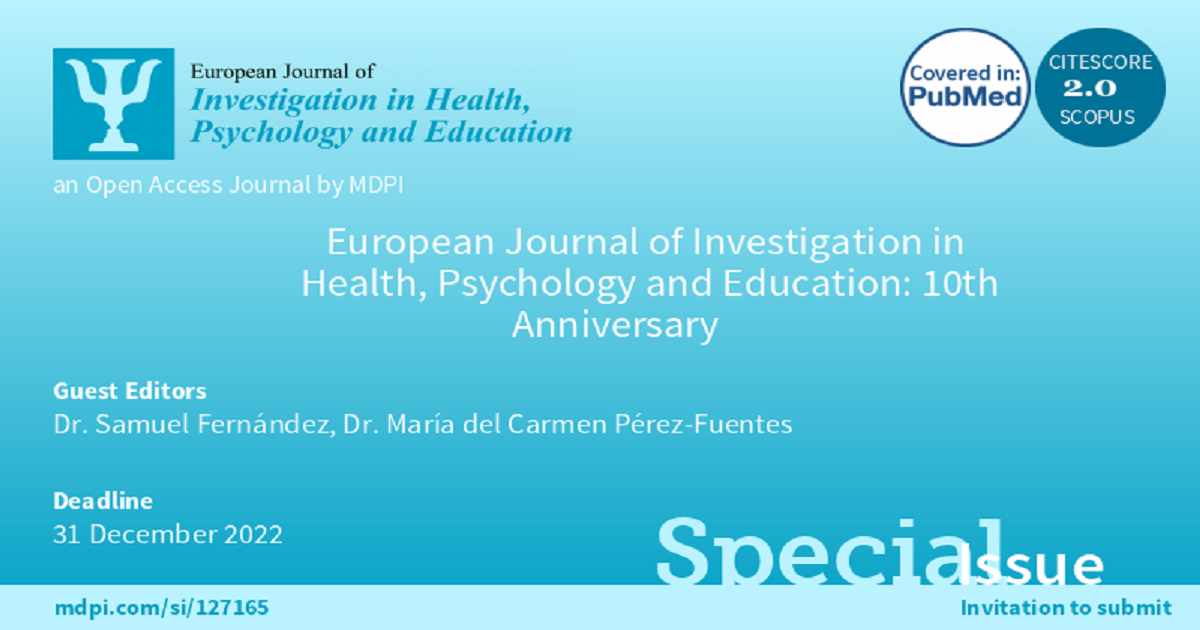European Journal of Investigation in Health, Psychology and Education: 10th Anniversary
A special issue of European Journal of Investigation in Health, Psychology and Education (ISSN 2254-9625).
Deadline for manuscript submissions: closed (31 December 2022) | Viewed by 305537

Special Issue Editors
Interests: organizational psychology; burnout; discrimination; social identity; occupational health; healthy organizations
Special Issues, Collections and Topics in MDPI journals
Interests: psychology of sustainability; engagement work; occupational health; psychosocial; organizational environments; personality; aggressive behavior; emotional intelligence; burnout; alcohol; tobacco; multilevel analysis; emotions; public health
Special Issues, Collections and Topics in MDPI journals
Special Issue Information
Dear Colleagues,
The year 2022 marks the 10th anniversary of the European Journal of Investigation in Health, Psychology and Education. The European Journal of Investigation in Health, Psychology and Education (ISSN 2254-9625) is a peer-reviewed, open access journal devoted to all aspects of research on health, psychology, and education in a coherent and practical way in order to study the human being from different perspectives or in different contexts, such as at the individual, family, social, or organizational levels. It is a journal of the University Association of Education and Psychology, and MDPI has been publishing the journal monthly in English since Volume 10, Issue 1 (2020). EJIHPE was accepted for coverage in the Scopus (CiteScore—Q2—Clinical Psychology), ESCI (Web of Science), PMC, and PubMed databases, among others.
To date, nearly 420 papers have been published in EJIHPE from more than 2000 authors, and 34 peer-reviewed articles have been cited 10 or more times (data up to 9 June 2022). We would like to sincerely thank our readers, innumerable authors, anonymous peer reviewers, editors, and all of the individuals who work for the journal in some way and who have contributed time and effort throughout the years. These achievements would not have been possible without your participation.
To celebrate this significant milestone, a Special Issue entitled “European Journal of Investigation in Health, Psychology and Education: 10th Anniversary” has been launched. This Special Issue will include high-quality papers on topics within the broad scope of health, psychology and education. It is our pleasure to invite you to contribute an original research paper or a comprehensive review article on a current trending topic for peer review and possible publication in the European Journal of Investigation in Health, Psychology and Education.
Dr. Samuel Fernández-Salinero
Dr. María del Carmen Pérez-Fuentes
Guest Editors
Manuscript Submission Information
Manuscripts should be submitted online at www.mdpi.com by registering and logging in to this website. Once you are registered, click here to go to the submission form. Manuscripts can be submitted until the deadline. All submissions that pass pre-check are peer-reviewed. Accepted papers will be published continuously in the journal (as soon as accepted) and will be listed together on the special issue website. Research articles, review articles as well as short communications are invited. For planned papers, a title and short abstract (about 250 words) can be sent to the Editorial Office for assessment.
Submitted manuscripts should not have been published previously, nor be under consideration for publication elsewhere (except conference proceedings papers). All manuscripts are thoroughly refereed through a single-blind peer-review process. A guide for authors and other relevant information for submission of manuscripts is available on the Instructions for Authors page. European Journal of Investigation in Health, Psychology and Education is an international peer-reviewed open access monthly journal published by MDPI.
Please visit the Instructions for Authors page before submitting a manuscript. The Article Processing Charge (APC) for publication in this open access journal is 1600 CHF (Swiss Francs). Submitted papers should be well formatted and use good English. Authors may use MDPI's English editing service prior to publication or during author revisions.
Benefits of Publishing in a Special Issue
- Ease of navigation: Grouping papers by topic helps scholars navigate broad scope journals more efficiently.
- Greater discoverability: Special Issues support the reach and impact of scientific research. Articles in Special Issues are more discoverable and cited more frequently.
- Expansion of research network: Special Issues facilitate connections among authors, fostering scientific collaborations.
- External promotion: Articles in Special Issues are often promoted through the journal's social media, increasing their visibility.
- Reprint: MDPI Books provides the opportunity to republish successful Special Issues in book format, both online and in print.
Further information on MDPI's Special Issue policies can be found here.







